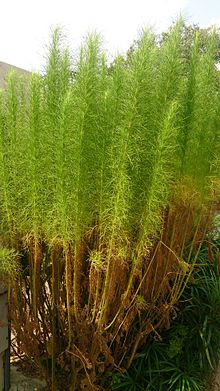Artemisia scoparia
| Artemisia scoparia | |
|---|---|

| |
| Scientific classification | |
| Kingdom: | Plantae |
| Clade: | Tracheophytes |
| Clade: | Angiosperms |
| Clade: | Eudicots |
| Clade: | Asterids |
| Order: | Asterales |
| Family: | Asteraceae |
| Genus: | Artemisia |
| Species: | A. scoparia
|
| Binomial name | |
| Artemisia scoparia | |
| Synonyms[3] | |
|
show
Synonymy | |
Artemisia scoparia is a Eurasian species in the genus Artemisia, in the sunflower family. It is widespread across much of Eurasia from France to Japan, including China, India, Russia, Germany, Poland, central + southwest Asia, etc.[4][5]
The English common name of Artemisia scoparia is virgate wormwood,[6] capillary wormwood,[6] or redstem wormwood. In Mandarin Chinese it is known as yīn chén (Traditional: 茵陳) and it is an important traditional Chinese medicine,[citation needed] and is considered interchangeable with for that purpose. Its pollen can be allergenic.[7]
Chemical constituents[]
- [8]
- (isoscopoletin-β-D-glucopyranoside)
- 7-Methoxycoumarin
- [9]
- Scoparone (6,7-dimethoxycoumarin) [10]
- Scopoletin
- β-Sitosterol
- Capillin
References[]
- ^ Tropicos search for Artemisia scoparia
- ^ Roxb. Hort. Bengal. 61 1814
- ^ The Plant List Artemisia scoparia Waldst. & Kitam.
- ^ Flora of China, 猪毛蒿 zhu mao hao, Artemisia scoparia Waldstein & Kitaibel, Descr. Icon. Pl. Hung. 1: 66. 1802.
- ^ Altervista Flora Italiana, Assenzio scopario, Artemisia scoparia Waldst. & Kit. includes photos and European distribution map
- ^ Jump up to: a b English Names for Korean Native Plants (PDF). Pocheon: Korea National Arboretum. 2015. pp. 360–361. ISBN 978-89-97450-98-5. Archived from the original (PDF) on 25 May 2017. Retrieved 25 January 2017 – via Korea Forest Service.
- ^ Jaggi KS; Gangal SV (1987). "Isolation and identification of pollen allergens of Artemisia scoparia". J Allergy Clin Immunol. 80 (4): 569–572. doi:10.1016/0091-6749(87)90008-X. PMID 3668120.
- ^ "Chemical Study on Artemisia scoparia". Archived from the original on September 30, 2007. Retrieved November 17, 2006.
- ^ Ali MS; Jahangir M; Saleem M (2003). "Structural distinction between sabandins A and B from Artemisia scoparia waldst. (Asteraceae)". Nat. Prod. Res. 17 (1): 1–4. doi:10.1080/10575630290020640. PMID 12674134.
- ^ Hoult JR; Payá M (1996). "Pharmacological and biochemical actions of simple coumarins: natural products with therapeutic potential". 27 (4): 713–722. doi:10.1016/0306-3623(95)02112-4. PMID 8853310.
Categories:
- Artemisia (genus)
- Plants used in traditional Chinese medicine
- Plants described in 1801
- Flora of Asia
- Flora of Europe
- Flora of Lebanon and Syria
- Asteroideae stubs
- Medicinal plant stubs